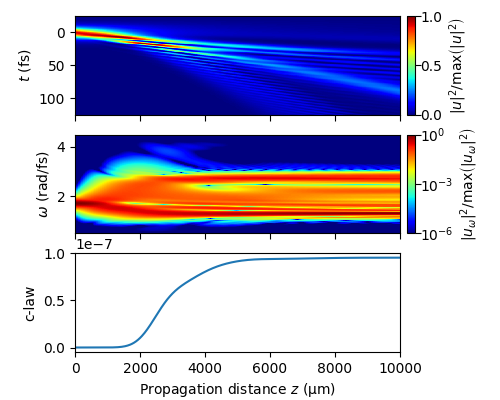Note
Click here to download the full example code
1.3.2. FMAS_S_R¶
This examples demonstrates photon number conservation for the simplified forward model for the analytic signal including the Raman effect (FMAS_S_R).
The considered propagation model provides a proper conservation law as class method claw. However, for clarity, we here re-implement the conservation law and explicitly pass this user-defined function to the solver class upon initialization.
As exemplary propagation scenario, the setup used in the step-by-step demo
is used.
import fmas
import numpy as np
from fmas.solver import IFM_RK4IP
from fmas.analytic_signal import AS
from fmas.grid import Grid
from fmas.propagation_constant import PropConst, define_beta_fun_ESM
from fmas.tools import sech, change_reference_frame, plot_claw
beta_fun = define_beta_fun_ESM()
pc = PropConst(beta_fun)
grid = Grid(t_max=5500.0, t_num=2 ** 14) # (fs) # (-)
Ns = 8.0 # (-)
t0 = 7.0 # (fs)
w0 = 1.7 # (rad/fs)
n2 = 3.0e-8 # (micron^2/W)
A0 = Ns * np.sqrt(abs(pc.beta2(w0)) * pc.c0 / w0 / n2) / t0
E_0t_fun = lambda t: np.real(A0 * sech(t / t0) * np.exp(1j * w0 * t))
Eps_0w = AS(E_0t_fun(grid.t)).w_rep
As model we here consider the simplified forward model for the analytic signal including the Raman effect (FMAS_S_R)
from fmas.models import FMAS_S_R
model = FMAS_S_R(w=grid.w, beta_w=pc.beta(grid.w), n2=n2)
For the FMAS_S_R \(z\)-propagation model we consider a conserved quantity that is related to the classical analog of the photon number, see Eq. (24) of [AD2010] and the appendix of [BW1989]. In particular we here implement
which is, by default, provided as method model.claw .
def Cp(i, zi, w, uw):
_a2_w = np.divide(
np.abs(uw) ** 2, w, out=np.zeros(w.size, dtype="float"), where=w > 0.
)
return np.sum(_a2_w)
As shown below, this conserved quantity can be provided when an instance of the desired solver is initialized. Here, for simply monitoring the conservation law we use the Runge-Kutta in the ineraction picture method. However, a proper conserved quantity is especially important when the conservation quantity error method (CQE) is used, see, e.g., demo
Stepsize adaption in the CQE method
solver = IFM_RK4IP(model.Lw, model.Nw, user_action=Cp)
solver.set_initial_condition(grid.w, Eps_0w)
solver.propagate(z_range=0.01e6, n_steps=4000, n_skip=8) # (micron) # (-) # (-)
The figure below shows the dynamic evolution of the pulse in the time domain (top subfigure) and in the frequency domain (center subfigure). The subfigure at the bottom shows the conservation law (c-law) given by the normalized photon number variation
as function of the proapgation coordinate \(z\). For the considered discretization of the computational domain the normalized photon number variation is of the order \(\delta_{\rm{Ph}}\approx 10^{-7}\) and thus very small. The value can be still decreased by decreasing the stepsize \(\Delta z\).
utz = change_reference_frame(solver.w, solver.z, solver.uwz, pc.vg(w0))
plot_claw(
solver.z, grid.t, utz, solver.ua_vals, t_lim=(-25, 125), w_lim=(0.5, 4.5)
)

References:
[AD2010] Sh. Amiranashvili, A. Demircan, Hamiltonian structure of propagation equations for ultrashort optical pulses, Phys. Rev. E 10 (2010) 013812, http://dx.doi.org/10.1103/PhysRevA.82.013812.
[BW1989] K. J. Blow, D. Wood, Theoretical description of transient stimulated Raman scattering in optical fibers. IEEE J. Quantum Electron., 25 (1989) 1159, https://doi.org/10.1109/3.40655.
Total running time of the script: ( 0 minutes 33.755 seconds)